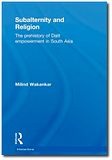Subalternity and Religion
Wakankar, Milind:
Subalternity and religion : the prehistory of Dalit empowerment in South Asia / by Milind Wakankar. - London and New York : Routledge, 2010. - xii, 202 S. - (Intersections. Colonial and postcolonial histories ; 2)
ISBN 978-0-415-77878-7 / 0-415-77878-6 (hbk.)
ISBN 978-0-203-85965-0 / 0-203-85965-0 (ebk.)
£ 80,00 / US$ 130,00
DDC: 200.86940954
Beschreibung
This book explores the relationship between mainstream and marginal or subaltern religious practice in the Indian subcontinent, and its entanglement with ideas of nationhood, democracy and equality. With detailed readings of texts from Marathi and Hindi literature and criticism, the book brings together studies of Hindu devotionalism with issues of religious violence.
Drawing on the arguments of Partha Chatterjee, Martin Heidegger and Jacques Derrida, the author demonstrates that Indian democracy, and indeed postcolonial democracies in general, do not always adhere to Enlightenment ideals of freedom and equality, and that religion and secular life are inextricably enmeshed in the history of the modern, whether understood from the perspective of Europe or of countries formerly colonized by Europe. Therefore subaltern protest, in its own attempt to lay claim to history, must rely on an idea of religion that is inextricably intertwined with the deeply invidious legacy of nation, state, and civilization. The author suggests that the co-existence of acts of social altruism and the experience of doubt born from social strife - 'miracle' and 'violence' - ought to be a central issue for ethical debate. Keeping in view the power and reach of genocidal Hinduism, this book is the first to look at how the religion of marginal communities at once affirms and turns away from secularized religion. [Verlagsinformation]
Inhalt
Preface. vii
PART 1: INTRODUCTION: THE QUESTION OF A PREHISTORY. 1
1. Subalternity at the Cusp: Limits and Openings in the Dalit Critique. 3
2. Moral Rite before Myth and Law: Death in Comparative Religion. 11
3. The Time of Having-Found (God): Languages of Dalit Hearsay. 25
PART 2: THE VICISSITUDES OF HISTORICAL RELIGION. 37
4. The Anomaly of Kabir: Historical Religion in Dwivedi's Kabir (1942). 39
5. The Pitfalls of a Dalit Theology: Dr Dharmvir's Critique of Dwivedi (1997). 75
6. System and History in Rajwade's Grammar for the Dnyaneswari (1909). 93
PART 3: THE PREHISTORY OF HISTORICAL RELIGION. 125
7. The Suspension of Iconoclasm: Myth and Allegory in the Time of Deities. 127
8. Miracle and Violence: The Allegorical Turn in Kabir, Dnyaneswara, and Tukaram. 147
9. Deity and Daivat: The Transfiguration of the Folk in Tukaram. 171
Notes. 188
Bibliography. 195
Index. 201
Autor
MILIND WAKANKAR teaches in the Department of English, SUNY Stony Brook, USA. He received his PhD in English and Comparative Literature and Postcolonial theory from Columbia University. His current work involves a monograph on Ramchandra Shukla and a critical commentary on the Dnyaneswari. Faculty profile.
Ähnlich
- Dalit Theology and Dalit Liberation
- Brueck: Writing Resistance
- Narrative Pattern and Genre in Hagiographic Life Writing
- Appleton: Narrating Karma and Rebirth
- Veer: The Modern Spirit of Asia
- Hindu, Buddhist and Daoist Meditation
- Jeremiah: Community and Worldview among Paraiyars of South India
- Scriptural Authority, Reason and Action
- Weber: Religion und Religionskultur
- Fenech: The Sikh Zafar-Namah

